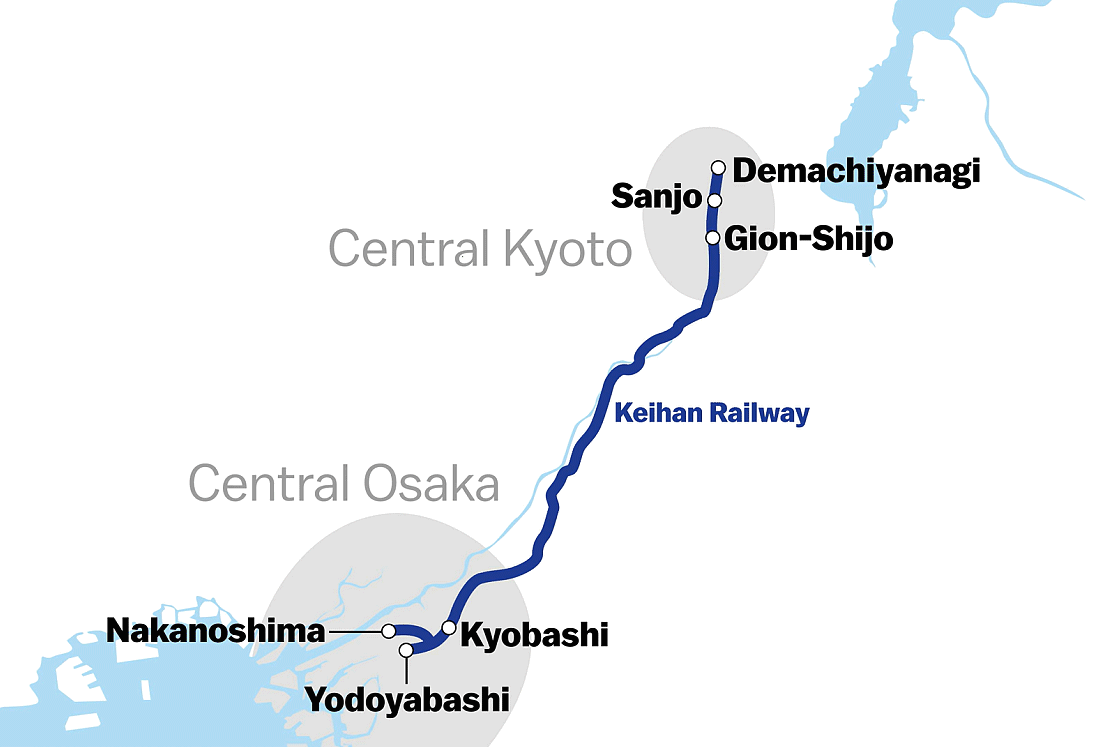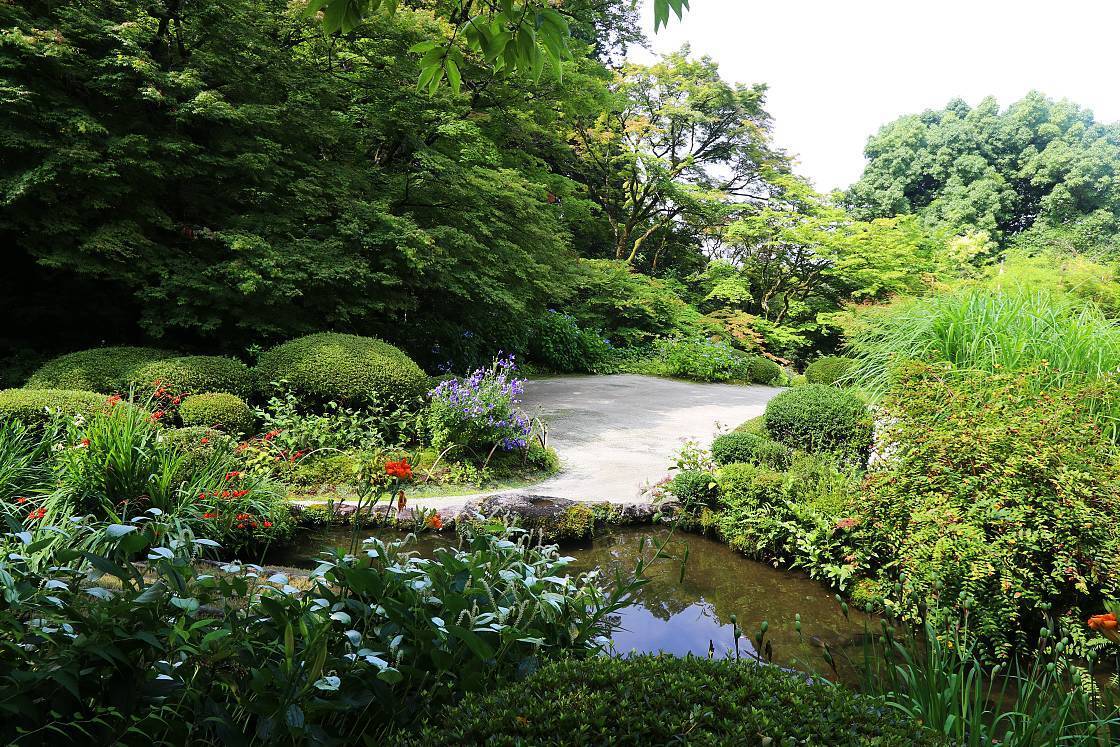Finding tranquility in Kyoto
The capital may have long since transferred to Tokyo, but for many natives and visiting foreigners alike, the heart of traditional Japan will forever remain in Kyoto. The birthplace of traditional art forms like the tea ceremony and home to the imperial family until 1868, Kyoto has retained a beauty and atmosphere that still exerts a powerful draw on the imagination. With upwards of 71 million tourists pouring into the city in 2022 and social media feeds filling up with images of packed streets however, many future visitors will be wondering where they can experience a more peaceful side to the city.
One of the major private railway companies operating in Japan's Kansai Region, The Keihan Electric Railway connects the cities of Kyoto and Osaka, providing easy access to popular sightseeing spots like Fushimi Inari Shrine, and Kiyomizudera Temple. Beginning in Osaka where it serves the midtown districts of Yodoyabashi, Nakanoshima and Kyobashi, the Keihan Railway extends to Kyoto, where it runs parallel with the Kamo River. The Eizan Railway picks up where the Keihan ends at Demachiyanagi Station, with two lines leading to the Kibune or Kurama area, and Hieizan.

For this one-day report, I set out to highlight both railways, while introducing some attractive local spots away from the crowds for an authentic and stress-free experience.
Setting off from Yodoyabashi Station in central Osaka, I began my day by taking a Keihan Railway train to Demachiyanagi Station in the northeast corner of Kyoto. Here, I changed to the Eizan Line for Ichijoji, with the journey taking an hour and ten minutes altogether.


Leaving the station, I took a 15-minute stroll due east through an increasingly residential neighborhood to the foot of Mount Uryu. Here, tucked away behind a humble wooden gate and a short garden path I found Shisendo - a beautiful Buddhist temple of the Soto Zen school, known for its serene atmosphere and attractive landscape garden.
Built in 1641, the temple began life as a retreat belonging to one Ishikawa Jozan, a hereditary retainer to the shogun Tokugawa Ieyasu and veteran of the historic Battle of Sekigahara. After retiring from service, he became a minor literary figure as well as a student of Zen - a theme still reflected today in the pieces of elegantly mounted calligraphy, the portraits of 36 Chinese poets, and in the name gShisendoh which means ghall of immortal poetsh.



Inside the main building, the zashiki or sitting area is fully open on one side to the garden, letting in the sound of a nearby stream and creating a feeling almost like hovering over an idealized natural landscape.
Stepping into the garden, the visitor soon discovers that it extends around and out of sight of the building, leading past a pond, patches of colorful flowers and finally a set of sculpted, miniature hills covered in a carpet of moss.



Leaving Shisendo behind I continued on my way, skirting the foot of the mountain to the north east for about 15 minutes until I arrived at my next stop of the day at Manshuin - a medium-sized temple complex in quiet, leafy surroundings.


Belonging to the Tendai school of Japanese Buddhism, the temple was founded in the 8th century and moved several times before arriving at its current location much later in the Edo Period (1603-1868). Said to have been inspired by concurrent renovations at the Katsura Imperial Villa, its then head priest - the imperial prince Ryosho - had it built in the same shoin zukuri style, with many of its interior fittings even produced by the same workshop.
Upon stepping inside, visitors can take in a series of beautifully painted rooms, each named after their theme, including the Tiger Room, Waterfall Room, Snowy Landscape Room and the Mount Fuji Room. Many of the paintings are attributed to members of the famous Kano School, the most influential and longest-lived schools of painting in Japanese history.


Especially famous are the Large Shoin and Small Shoin, both considered outstanding examples of the Shoin style and featuring elements easily recognizable from traditional Japanese rooms today, from their tatami floors and removable sliding doors to smaller details, like the staggered shelves and little study desks.
Both rooms open onto a spectacular garden in the dry rock style, with two miniature islands rising out of a sea of raked gravel. On one of the islands stands a 400 year old pine tree whose interesting shape is said to resemble that of a crane.




By now it was approaching lunchtime, so after thoroughly exploring the temple I began to work my way back towards the station in search of something tasty to eat.
Fortunately, just west of the station along Higashioji Dori is an area often known as the Ichijoji Ramen District due to the many ramen shops lining the streets there. Originally a food hub for students at nearby universities, its reputation quickly grew due to the intense competition, with each shop offering its own distinctive take on the classic dish.
Among the 15 or so ramen restaurants in the area, one of the most famous is Men-ya Gokkei, known for its thick and rich tasting chicken broth. Stopping here for lunch, I ordered their signature dish which certainly didn't disappoint - with fresh, perfectly cooked noodles and a delicious, meaty broth.


After my meal, I retraced my steps to Ichijoji Station and took a six-minute ride south along the Eizan Main Line to Demachiyanagi - a quiet neighborhood at the junction of the Takano and Kamo rivers.
Although perhaps best known for the nearby Shimogamo Shrine - a popular spot to usher in the new year - the neighborhood also has its share of interesting local spots, while the grassy spaces along the river offer a scenic respite from the heat in summer.


My second to last stop of the day was just a short walk from the station at Matsui Shuzo - a sake brewery with a 300-year history, and one of just a handful operating in central Kyoto. Here I joined a quick but satisfyingly detailed tour, given in English by an experienced member of the brewing staff.


With the basics of sake brewing covered, I took a seat in the brewery's nicely furnished tasting area to put that newfound knowledge to good use. To match the brewery's polished, modern look, the tasting process is entirely automated, with each guest using a pre-paid card to fill miniature cups from a well-stocked machine.
With its pleasant atmosphere and so many bottles to try, I could have easily spent a few hours there - and of course if you do find the perfect bottle, you can always bring it home with you!


In a city like Kyoto, where there is so much to see and never enough time to fit it all in, it's easy to miss out on quieter experiences like simply exploring a neighborhood and taking in the flow of local life. With this in mind, I decided to end my day in Kyoto with a stroll around the nearby Demachiyanagi Shopping Street - a pleasant little shopping arcade with a nice selection of shops and cafes.


My first stop here was at Otafukuya, a nice little traditional sweet shop located just inside the arcade's east entrance, where some matcha flavored minazuki - triangular slices of sticky mochi topped with red azuki beans - immediately caught my eye.
Literally meaning "watery moon", minazuki take their name from an old name for the month of June, when they are often eaten, and moonlight can be seen reflecting in rice fields flooded by rainwater.

Visitors to the arcade can also sip coffee while taking in some locally inspired art at the Delta/Kyotographie cafe, which doubles as an exhibition space. Kyotographie organizes an international photography festival once a year in some of Kyoto's popular spots, but if you happen to miss it, this is definitely the next best thing.


